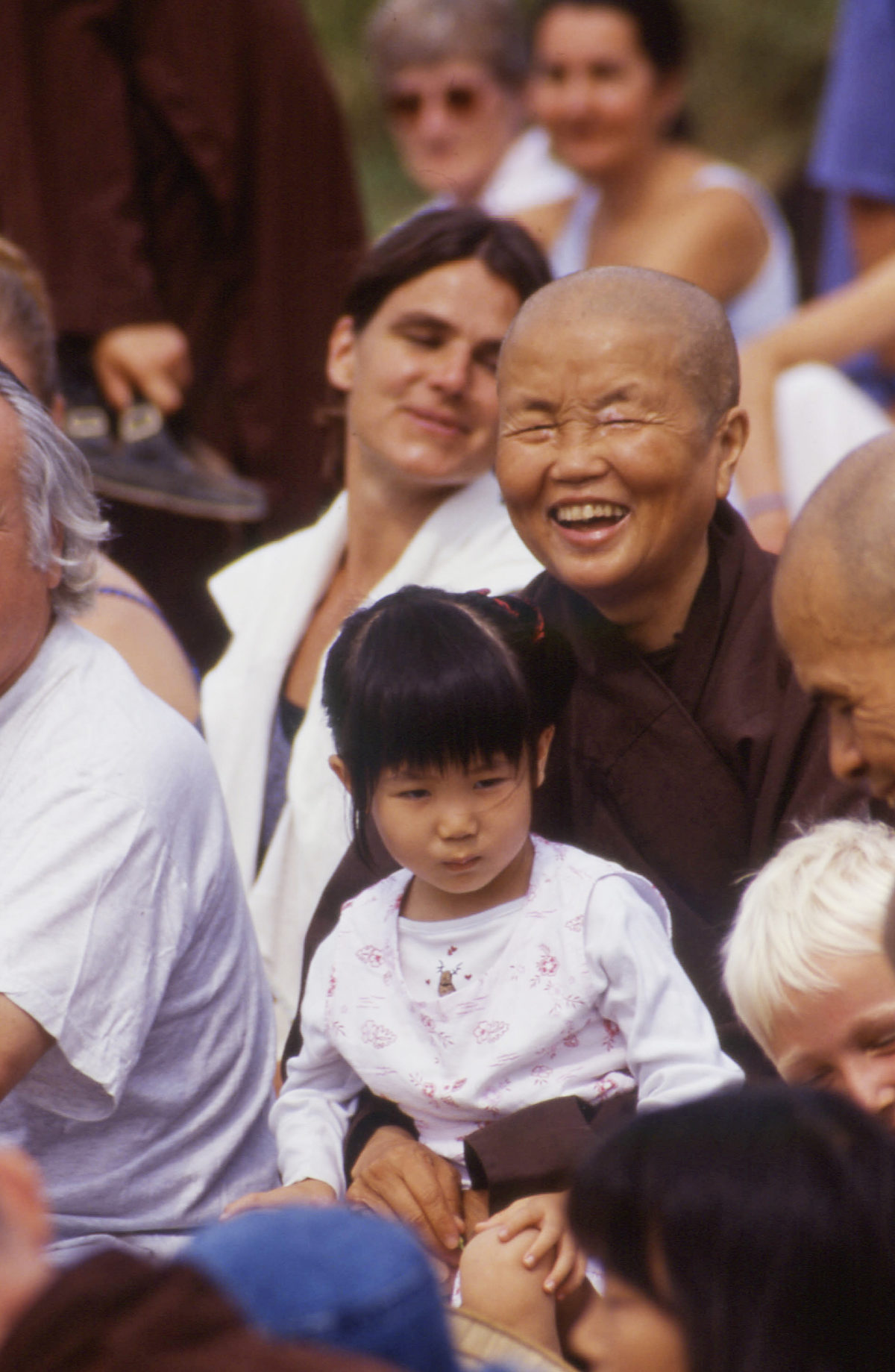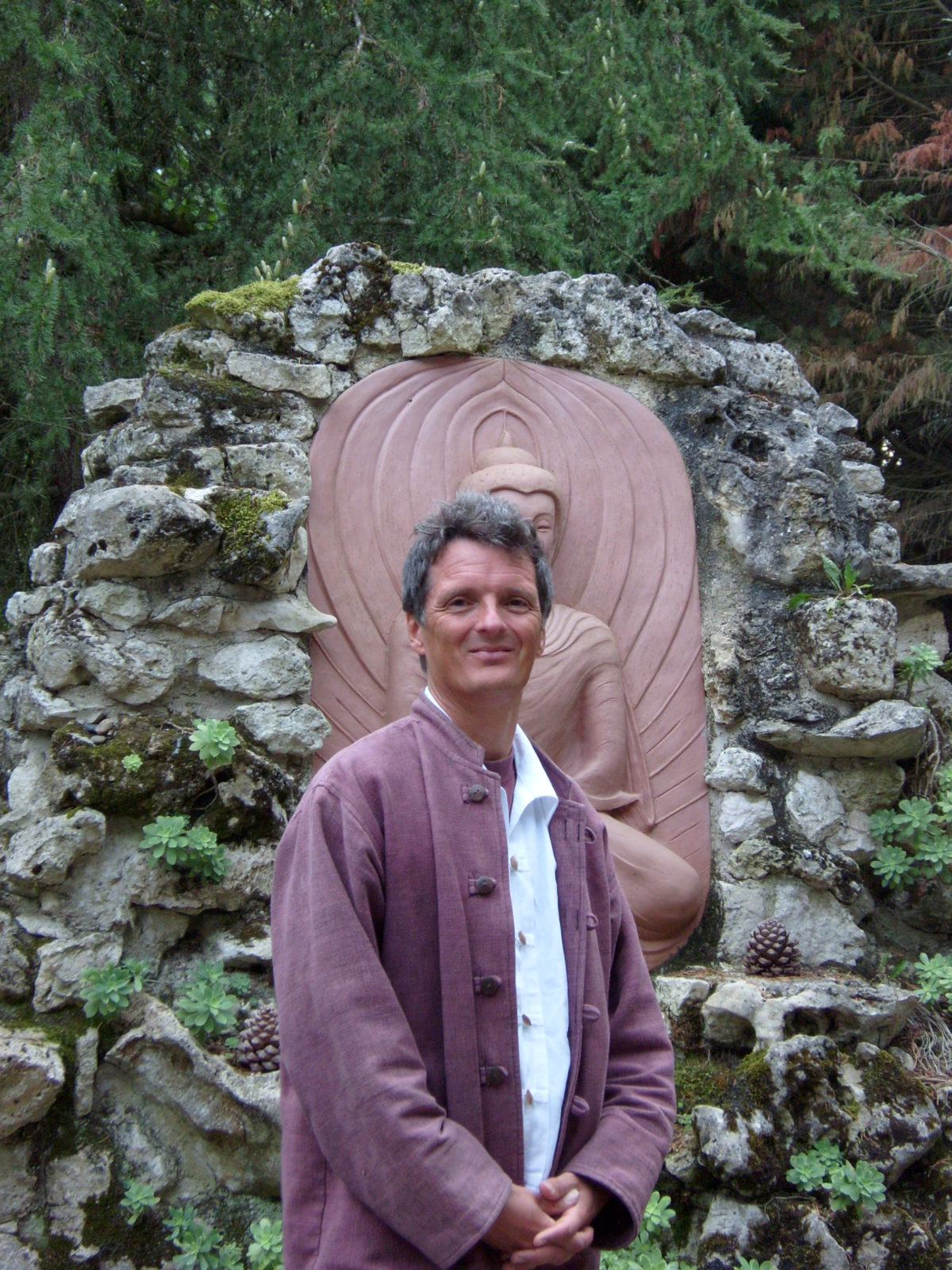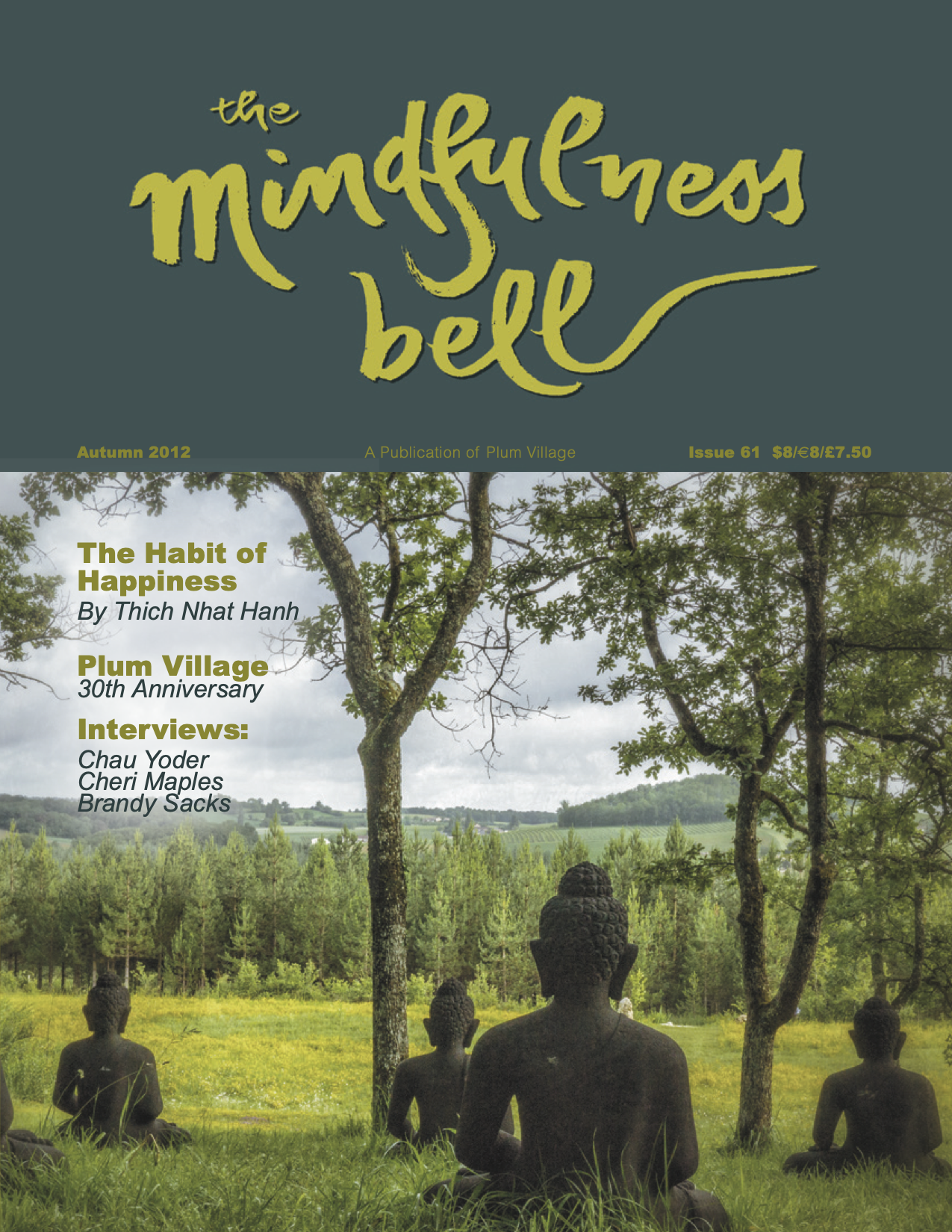By Paul Tingen
My first visit to Plum Village, twenty-two years ago, is still as vividly engrained in my memory as if it happened last week, probably because it was packed with surprises, ranging from the eyebrow-raising to the jaw-dropping. I arrived in Lower Hamlet on a warm evening in July 1990 during the Summer Opening. The first person I encountered was Shantum Seth, who looked rather splendid in his Indian outfit and who seemed to be the only one who had an overview of what was happening.
By Paul Tingen
My first visit to Plum Village, twenty-two years ago, is still as vividly engrained in my memory as if it happened last week, probably because it was packed with surprises, ranging from the eyebrow-raising to the jaw-dropping. I arrived in Lower Hamlet on a warm evening in July 1990 during the Summer Opening. The first person I encountered was Shantum Seth, who looked rather splendid in his Indian outfit and who seemed to be the only one who had an overview of what was happening. As I put my ruck- sack down, I asked him where I could sleep, and he replied, “You can put your tent anywhere, or sleep in a room.” I looked around for where I could pitch up my tent, but Shantum’s next question stopped me in my tracks. “You want to join the evening meditation? It starts in half an hour.”
I’d just hitchhiked from London and was tired, but I was also eager for my first experience of what Plum Village was about, so I said yes. Half an hour later I sat in the Red Candle Hall, puzzled by the fact that we were facing the wall and not one another, and impressed by the sound of the big bell. The session turned out to be a guided meditation on death, with phrases like: “Breathing out, I see my dead body festering.” The whole meditation was a visualization of the process of one’s own corpse decaying until it turned to dust. I was shocked. Some part of me guessed that this was about training our minds to get used to the idea of physical death and to chip off bits of the big rock of our fear of death, but at the same time, as a horror show of images paraded through my mind, I thought, “Are these people morbid or something? Have I ended up in the clutches of some crazy religious sect?”

Fateful Decision
The fact was, at that point I knew nothing about the practice. The reason I was in Plum Village was that a few months earlier, in April, I had attended a talk by Thay in London. At that time a series of mostly New Age talks was held every Monday night in St. James’ Church, near Piccadilly Circus. I was on a spiritual search for the meaning of life, the universe, and everything, and I also had a lot of suffering that I didn’t know how to transform, so I went every Monday night, looking for answers. I had no idea who Thich Nhat Hanh and Sister Chan Khong were. After everyone had taken their seats, Sister Chan Khong sang to us and explained the practice of the bell, and there was a lot of stopping, going slowly, and breathing. I recall thinking, a bit impatiently, “This is going to be a long evening.” I looked at the exit and considered going to a local café to have some cake and coffee and coming back later to meet some friends. Then Thay came forward, and from halfway down the church he looked like he was thirty-five years old. Add his gap-toothed smile, soft voice, and extremely simple language, and I remember thinking, “Who is this young upstart and what does he know?” My decision to delay my exit for coffee and cake for a few more minutes turned out to be one of the most fateful of my life.
Ten minutes later I was hooked. Not long afterwards, I started to cry. I cried for the rest of Thay’s talk. When I occasionally looked around me, I saw that at least half the people in the audience were actively weeping. Thay’s talk was extraordinary, and as he kept talking, I realized that there was a wealth of experience, wisdom, depth, and insight behind his very simple words. The main thing I recall is that I was deeply touched by his attitude toward suffering. He acknowledged suffering with compassion and without judgment. It was okay to suffer. Thay showed a way that accepted and embraced suffering with tenderness, but he also offered a way out of suffering that was light, simple, and delicious. As he talked I kept being stunned at how much of what he said was common sense. I recognized everything he said as obvious life truths, yet I’d never heard anyone formulate them before. At that point I had an inkling that I’d found my teacher, and to this day my life is separated into the time before and the time after that April evening.
Naturally, when I found out that Thay had a centre in the south of France, one of my favourite areas in the world, I decided to go. And so a few months later I found myself sitting in the Lower Hamlet Red Candle Hall with horror movie images running through my head. I didn’t immediately plan my exit, but I did go to sleep with mixed feelings. The next morning we all went to Upper Hamlet for Thay’s Dharma talk, which was in the Transformation Hall. The Summer Retreat was attended by perhaps two hundred people, and while most fit in the hall, a couple of dozen listened under the linden tree. Thay was only five minutes into his talk when I experienced the same feelings I had had in London a few months earlier. I was deeply touched, and the doubts that had arisen the evening before fell away. He was indeed my teacher. I had arrived.
A New Direction
Life in Plum Village in 1990 was very different than it is now—for starters, the schedule. I remember that we got up at approximately 6:30 a.m. and began practice at 7:00 a.m. Morning practice consisted of the round of sitting-walking-sitting meditation, followed by sutra reading with sometimes a bit of chanting. Breakfast started at 8:30 or 9:00 a.m. Thay’s Dharma talk was planned for 10:00 or 10:30 a.m., but because he took so long to casually stroll towards the hall, while chatting with people on the way, he often didn’t start until later. Thay’s Dharma talks often were long, so lunch tended to be at 1:30 or 2:00 p.m., after which there was rest time. Walking meditation was usually at 4:30 or 5:00 p.m., and after dinner there was another sitting-walking-sitting meditation session beginning at 8:00 or 8:30 p.m. (I invite those with better memories than mine to correct these times if I haven’t got them quite right.)
In addition to Thay, there were only three other monastics living at Plum Village: Sister Chan Khong, Sister Annabel, and Sister Jina (who was still walking around in very striking black and white Japanese robes). Thay and Sister Chan Khong were very available and approachable. Thay would chat with loads of people, particularly before his Dharma talks. Very early on during my stay, he heard me playing my acoustic guitar under the linden tree, and he approached me and asked if I would be willing to play guitar in the meditation hall before the Dharma talk, to calm people down and keep chatting to a minimum while they waited for him. I was very happy to oblige, and it was the beginning of a whole new musical direction for me. When he arrived thirty to forty-five minutes later, he’d sit next to me, listening and waiting for me to finish my piece, after which we bowed to each other and I left the stage.
It was fairly easily organized in those days to have tea with Thay, and during this occasion I remember being struck by seeing Erich Fromm’s The Art of Loving among the five books on his bookshelf. Sister Chan Khong was also very approachable, and I regularly sat next to her in an old Peugeot 505, mostly driving between Upper and Lower Hamlet. I have no idea why we went up and down so often, but it gave me a chance to talk about what was bothering me. She was always very present, and many of her pearls of wisdom are still with me today. I was practicing in an esoteric Christian tradition at the time, and in response to my feeling uneasy about the Buddhist aspects of Plum Village she replied, “You don’t need to feel this is your home; just relax and regard it as a hospital for you to heal.” To my question about how to stay mindful when playing rock and roll on my electric guitar, she advised, “Just breathe before you play, and breathe again after you play.” Simple, and no judgment. She also told me, “Don’t think about what’s bothering you all the time. Breathe and focus on other things, and then, when you’re no longer thinking about it, a solution will suddenly pop into your head.”
It was also Sister Chan Khong who at one point tapped me on the shoulder and gently asked, “Why don’t you join the walking meditation?” As a left-leaning young man who had been strongly influenced by the counter-culture movement of the 1960s, I had a strong habit energy of rebellion and non-conformism, and didn’t immediately join in with all the practices. The immense tolerance in Plum Village was therefore a godsend for me. For example, for more than a year I refused to bow. Once someone gently asked me why and then appeared to happily accept my answer. There was no pressure to do anything or be anything other than myself. This gave me the space to discover for myself what bowing is about, and when I realised that honouring the Buddha in the other person is a very beautiful practice, I could bow from a place of total authenticity. To this day, bowing is an important practice for me that feels completely comfortable and genuine.
I felt that Thay and Sister Chan Khong personally took me under their wing and opened doors for my Plum Village experience—Sister Chan Khong with her compassionate listening and wisdom, and Thay in encouraging me to follow the new musical direction I had taken. Until my first visit to Plum Village, I was involved in making rock music, but it never felt quite right. With Thay’s encouragement, more and more acoustic guitar pieces came rolling out of me, and I eventually realised that this was my true musical voice. I recorded parts of my first CD in Plum Village in 1993, something that Thay personally made possible, saying that he wanted the community to be able to support artists.
Presence of Compassion
Until I (temporarily) moved to the U.S. in 1999, I travelled several times a year from England to Plum Village, and every time I arrived I noticed changes that were not to my liking. For example, the wake-up time became earlier and earlier; there were more people, more buildings, and stricter practice; men and women were separated between the hamlets; and gradually Sister Chan Khong and particularly Thay became less available to laypeople. Every time I initially thought, “Oh, no!” And yet, every time, this reaction dropped away within hours as I noticed that the energy of the practice and the presence of compassion and understanding were the same as the last time I visited.
However, as the morning wake-up time became earlier and earlier, I did become a morning meditation truant, eventually abandoning that practice altogether. I could barely function for the rest of the day when I did attend. And after my first child was born in 2002, and sleepless nights became the norm, I learned to grab every second of sleep that I could.
And then, one summer morning in Upper Hamlet a few years ago, I woke up at 5 a.m. and couldn’t get back to sleep. I went to the big meditation hall, arriving fifteen minutes early for the morning meditation. A few people were already there, and I sat down far away from them, in a quiet corner where I expected to have a lot of space to myself. I had just settled in my meditation when I heard someone enter the hall, move slowly in my direction, and sit down right beside me. I wondered who would choose, out of all the free places in the hall, the seat immediately to my left. I glanced sideways. It was Thay.

Paul “Ramon” Tingen, True Harmony of Loving Kindness, is an anglicised Dutchman who now lives in France, near Plum Village. Paul writes for music technology magazines and is the author of a book about the electric music of Miles Davis entitled Miles Beyond. Paul has recorded one CD, May the Road Rise to Meet You, and is currently recording a second album. He ordained as an OI member in 1997. His website is www.tingen.org.

